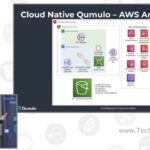|
|

Dack Busch presented for Qumulo at CFD21 |
This video is part of the appearance, “Qumulo Presents at Cloud Field Day 21“. It was recorded as part of Cloud Field Day 21 at 11:00-12:30 on October 23, 2024.
Watch on YouTube
Watch on Vimeo
Qumulo’s cloud-native architecture, as presented by Dack Busch, emphasizes elasticity, performance, and cost-efficiency, particularly in AWS environments. The system is designed to scale dynamically, allowing users to adjust the number of nodes in a cluster based on workload demands. This flexibility is crucial for industries like media and entertainment, where workloads can spike unpredictably. Qumulo’s architecture allows users to scale up or down without service disruption, and even change EC2 instance types in real-time to optimize performance and cost. The system’s read cache is stored locally on NVMe drives, while the write cache is stored on EBS, which is more cost-effective and ensures data durability. The architecture also supports multi-AZ deployments, ensuring high availability and durability by spreading clusters across multiple availability zones.
One of the key features of Qumulo’s cloud-native solution is its integration with S3 for persistent storage. The system defaults to S3 Intelligent Tiering, but users can choose other S3 classes based on their needs. The architecture is designed to be highly efficient, with a focus on data consistency and cache coherency. Unlike some cloud systems that are eventually consistent, Qumulo ensures that data is always consistent, which is critical for customers who prioritize data integrity. The system also supports global namespace metadata, allowing users to access their data from anywhere as if it were local. This is particularly useful for scenarios where data needs to be accessed across different regions or environments, such as in disaster recovery or cloud bursting scenarios.
Qumulo’s architecture also offers significant economic advantages. Customers only pay for the capacity they use, and there is no need to provision storage in advance. This pay-as-you-go model aligns with the principles of cloud-native design, where resources are only consumed when needed. The system also supports automated scaling through CloudWatch and Lambda functions, allowing users to add or remove nodes based on real-time performance metrics. Additionally, Qumulo’s integration with third-party tools and its ability to ingest data from existing S3 buckets make it a versatile solution for organizations looking to migrate or manage large datasets in the cloud. The demo showcased the system’s ability to scale from three to 20 nodes in just a few minutes, demonstrating its real-time elasticity and high-performance capabilities.
Personnel: Dack Busch









